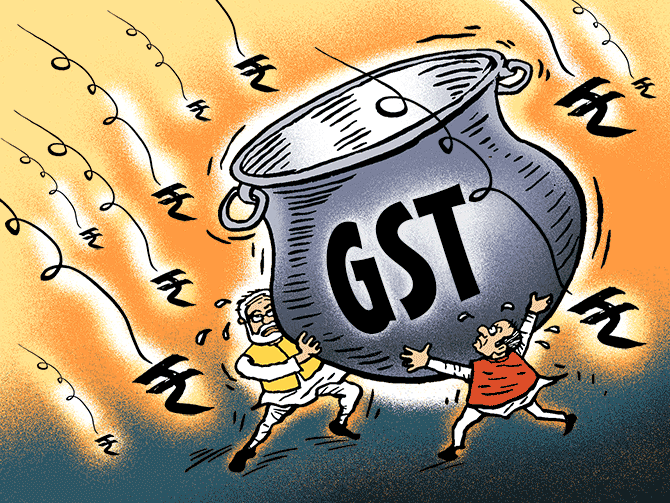Is the curated and limited data put out by the central government sufficient enough to pass a judgement on the trend in GST collections, particularly that of the Centre?
Illustration: Dominic Xavier/Rediff.com

The National Democratic Alliance government celebrated one year of GST on July 1.
The official releases by the government through different media channels spoke of the progress made in implementing the tax and what it was achieving for the economy.
But references to one central concern were missing - whether taxes collected under GST are improving, or not.
Earlier, in April finance minister Arun Jaitley rejoiced when monthly gross Goods and Services Tax (GST) collections crossed the Rs 1 trillion mark for March 2018. He called it a “landmark” and claimed that “GST collections would continue to show a positive trend” in coming months.
But, collections for April fell marginally, to Rs 94,000 crore.
In response to the collections, finance secretary Hasmukh Adhia then said: “GST April revenue: Some people are comparing April collection figure with March which is not correct. April is traditionally the month of lowest monthly collection.”
The collections for April seemed to have worried Adhia. He shot a note to central government tax officials saying that the “performance of central government officers is worse than the state government expect in a couple of states.”
In the letter Adhia berated the central tax officers for performing worse than their state counterparts on both lower than expected tax collections and tax filings.
In a rare show of defiance the revenue officials retorted, saying it was erroneous to compare collections for April with previous months (Jan and Feb) on account of seasonality in collections and other factors.
The Controller of General Accounts shows that the GST collections for May have done worse than April.
These contradictory trends and statements bundled with the disagreements within the government over the trend in GST collections, again beg the question - how well is GST really doing?
Is the curated and limited data put out by the central government sufficient enough to pass a judgement on the trend in GST collections, particularly that of the Centre?
The answer to the first question is difficult to come by because the answer to the second question is ‘no’.
The government does not disclose month-wise granular data on an accrual basis - i.e. show the tax collections, net off refunds, set-offs and readjustments against the relevant month they accrued or pertain to.
It shows them on a cash-basis - reflecting them in the month the collections are made or delayed refunds are adjusted.
GST for a specific month is collected till the end of the next month.
This collected amount has to be set-off against refunds, adjustments and reapportionment of IGST into CGST and SGST.
Reconciling all these accounting transactions for a particular month provide the real picture of how much revenue accrued in that month.
But, the government reflects GST collections and the adjustments as and when they take place - even when many of these adjustments occur months after the period they pertain to, such as export refunds.
With a centralised and online database for the entire country, the GSTN, at its command the government could provide accrual-based reconciled data.
Business Standard asked for month-wise data for all components of GST on an accrual basis through RTI. The ministry claimed it did not hold the information and forwarded the application to the Central Board of Indirect Taxes and Customs.
The Board is yet to reply. Business Standard also sent direct queries to the ministry for the data. The ministry did not respond.
The intrinsic complexity and rolling nature of GST input credit and refunds, coupled with haphazard implementation in the first year compounds the challenge of assessing the month-on-month improvement or trends in tax collections based on the information the government currently puts in public domain.
Settling the GST components
The GST tax regime has four components. Central GST, state GST, Integrated GST and compensation cess.
While they are collected at one shot, the Union government gets to keep the Central GST and is apportioned a part of the Integrated GST, which is imposed on inter-state transactions.
But, the money collected as Integrated GST in 2017-18 has not been apportioned regularly into CGST and SGST as it should be.
In fact, by the end of 2017-2018, Rs 1.69 trillion remained unapportioned, shows Controller General of Accounts.
Take another example. CLSA, an investment firm’s analysis of figures released by government shows that in April, for the month of March 2018, Rs 50,500 crore was collected as IGST and Rs 28,400 crore was apportioned to CGST and SGST.
But even from this analysed information one cannot tell in which months the apportioned IGST actually accrued to the government.
The government expects the apportioning of IGST to states and centre to improve with time.
The 2018-19 budget documents assume only Rs 50,000 crore would remain unapportioned by the end of March 2019.
Refunds
Under the GST regime businesses are able to claim several types of refund on the GST deposited.
A large part of these refunds arise from exports. But settlement of export-linked refunds has been a big problem so far.
The government recently began special drives to ensure refunds pending for months to be resolved.
In affect refunds being made in 2018-19 year could also pertain to 2017-18.
If accounts were available on accrual and net-off basis, the net collections for various months in 2017-18 would show a reduction for each of such refunds.
The Controller General of Accounts’ monthly numbers on tax collection, come closer to reality.
But, with refunds and settling of IGST taking longer than the time CGA takes to finalise accounts for a particular month, even these do not reflect the true picture.
The difference between CGA’s net tax collection numbers and the gross early estimates put out by the finance ministry through press release are telling of how the final figures, after refunds and adjustments of different GST components, can be drastically different.
Take the example of CGST collections for January 2018 in February. The CGA shows CGST collected (including apportionment from IGST) was Rs 43,100 crore.
The finance ministry press release said it was Rs 25,560 crore.
A tax expert told Business Standard that any input credit rolling over from month to month on a steady click in a stabilised GST regime could be ignored to see underlying trends.
It was done in the previous indirect tax regimes in the states and Centre. But the outstanding and unapportioned IGST did pose a challenge in understanding how well GST is doing, he admitted.
The difference between the earlier multiple tax indirect regimes that states and the Centre ran and the single GST regime which replaced it, is that the government can do better now in reflecting the real collection numbers - all tax transactions are digitised and on a central database, easily amenable to better collation on an accrual basis.
But the government not begun sharing this data with public.
As a central indirect tax official posted in one of the states said, “At the moment, even we are going by the press releases from the finance ministry.”











